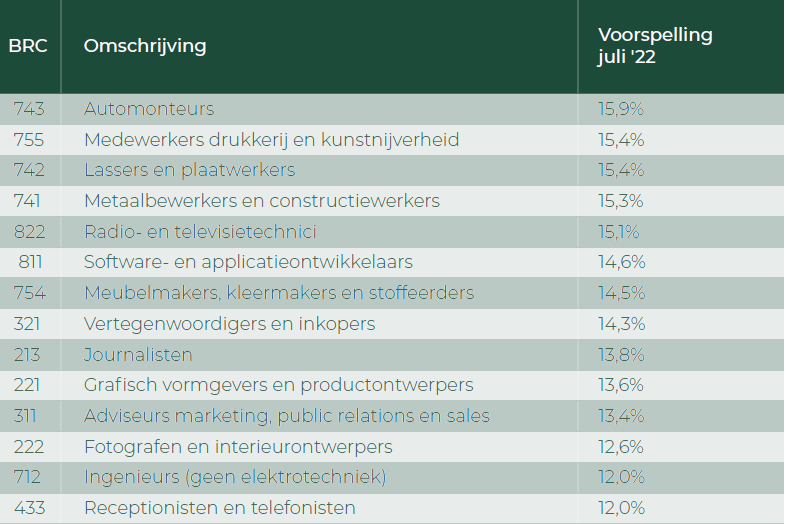By 2030: 1 in 10 in Dutch labor market IT professional
Currently, one in seventeen people in the Dutch labor market is an IT professional. In ten years, this has nearly doubled. At the current growth rate of nearly seven percent per year, by 2030, one in ten of the labor force will be an IT professional. That said, the battle for salaried and temporary IT professionals, self-employed and employed by secondment companies, is in full swing. Sourcing pressure - the percentage approached at least once a quarter - is unprecedented at nearly 65 percent, especially given the 37.6 percent average for the entire workforce
IT workers gone mainstream
Analysis by HR tech service provider HeadFirst Group and labor market data specialist Intelligence Group shows that by September 2022, the demand for salaried IT professionals (25,000) will be almost eight times greater than the demand for IT professionals (3,000). Geert-Jan Waasdorp, director and founder of Intelligence Group, says: "IT professionals have lost their special place in the labor market. The field is no longer a niche, but an integral part of business operations. To have IT knowledge properly embedded in the organization, more IT professionals are needed on a permanent basis. Supplemented by temporary IT professionals, who bring specific IT knowledge."
As a result of this rising demand, the occupational group is classified as the tightest in the UWV's stress indicator - the number of vacancies open divided by the number of people receiving unemployment benefits for less than six months. Despite the number of IT workers increasing by 6.9 percent year on year
Recruiting IT professionals remains difficult
Currently 580 thousand people work within IT occupations. The part that is employed has an extremely low labor market activity of 6.8 percent. Compared to the entire Dutch labor force, this is about half (11.5 percent). The proportion of IT workers with permanent jobs who are not looking for new work at all in the second quarter of 2022 is 42.7 percent. Just over half (50.5 percent) are latently - or not actively - looking and only 6.8 percent are actively looking. The labor market activity of IT professionals is more mobile: the number of active job seekers is 22.4 percent, 46.9 percent are latently looking and 30.7 not at all.
Marion van Happen, CEO HeadFirst Group, explains, "There is increasing competition among organizations to get the attention of latent job and assignment seekers. With the use of labor market communication, the emphasis is placed on selling the vacancy or assignment and the job or client. Salary and other benefits have become hygiene factors, the content and relevance of the work are now the critical recruitment factors."
On Tuesday, Oct. 18 at 10 a.m., the survey findings will be shared in a webinar. You can register via the Intelligence Group website. After that, the full Talent Monitor will be made available at hfgroup.headfirst.group.
Inflation driving rate hike for self-employed workers
The ECB announces a 0.5 percentage point jump in interest rates, aiming to stem the surge in euro zone inflation. Motivated in part by current inflation, inflation expectations of 5.2 percent on average and an exceptionally scarce labor market, flexible workers have become on average 4.7 percent more expensive in the first six months of 2022.
The hourly rate of self-employed workers and professionals employed by secondment firms is expected to have increased by an average of 10.3 percent by the end of the year. Over 3 percentage points more than we predicted - in collaboration with labor market data specialist Intelligence Group - in December 2021.
This acceleration, in addition to faster rising inflation, is due to persistent scarcity in the labor market. The number of offers per job was 7 percent lower than in 2021. In addition, the uncertainty surrounding corona has diminished, which was there at the end of 2021 and then caused a small pressure on pricing.
Increase in salaries continues to lag
Salaries are also experiencing record increases, according to recent figures from the employment conditions advisor to Dutch employers AWVN. A record monthly average of 3.8 percent in June puts the average agreed wage increase for the first half of 2022 at 3.1 percent. This does leave salaries behind the Central Planning Bureau's inflation forecast of 5.2 percent on average and the average rate increase of professionals.
Flexible workers benefit more quickly from rate trends because of the succession of different assignments. Of course, it also means that rates are more likely to fall when the labor market is less scarce and inflation is lower, which rarely if ever happens with collective bargaining agreements. Thus, entrepreneurs - which is what zzp'ers and posting agencies are - bear both the joys and the burdens of the important, flexible role they play in keeping our labor market, and thus our economy, running.
Auto mechanics farm well
Auto mechanics can expect the largest hourly rate increase this year at 15.9 percent, followed by printing and arts and crafts workers and welders and sheet metal workers (15.4 percent). In addition, metalworkers and construction workers, radio and television technicians, software and application developers and cabinetmakers, tailors and upholsterers are predicted to benefit from an hourly rate increase of about 15 percent. Construction finishers can expect the lowest hourly rate increase at 6.8 percent, followed by plumbers and pipe fitters (7.3 percent). In addition, hourly rate increases for carpenters, structural construction workers and painters and metal sprayers are not predicted to exceed 8 percent in 2022
About Talent Monitor
Each quarter Intelligence Group and HeadFirst Group make available unique insights on labor market related themes based on Intelligence Group's recruitment and labor market data, combined with HeadFirst Group's hiring data. Download the Talent Monitor 'Update - forecast rate development professionals 2022' on the hfgroup.headfirst.group website.
Accelerated rate hike averaging 10.3 percent for self-employed and secondees in 2022
More than 3 percentage points higher than forecast in December 2021
Flexible workers, more specifically, self-employed workers and professionals employed by secondment agencies, have increased in price by an average of 4.7 percent in the first six months of 2022. Over the whole of this year, 10.3 percent rate increase is expected, with inflation and scarcity being the driving forces. This is according to data and the rate forecasting model from labor market data specialist Intelligence Group and HR tech service provider HeadFirst Group. This exceeds the average agreed wage increase for permanent staff, which remained stuck at 3.1 percent for the first half of 2022.
Inflation and scarcity drive hourly rate up further
The hourly rate is expected to increase by an average of 10.3 percent by the end of the year. More than 3 percentage points more than HeadFirst Group and Intelligence Group predicted in December 2021. Geert-Jan Waasdorp, director and founder of Intelligence Group: "On the one hand, this acceleration is due to faster rising inflation and persistent scarcity in the labor market. On the other hand, the uncertainty around corona has diminished, which was there at the end of 2021 and then caused a little pressure on pricing."
Increase in salaries continues to lag
Salaries are also experiencing record increases, according to recent figures from the employment conditions advisor to Dutch employers AWVN. A record monthly average of 3.8 percent in June puts the average agreed wage increase for the first half of 2022 at 3.1 percent. This does leave salaries behind the Central Planning Bureau's inflation forecast of 5.2 percent on average and the average rate increase of professionals.
Marion van Happen, CEO at HeadFirst Group: "Flexible workers benefit faster from rate developments due to the succession of different zzp assignments. Naturally, it also means that rates are more likely to fall in a less scarce labor market and lower inflation, which rarely if ever happens with collective bargaining agreements. Thus, entrepreneurs - which is what zzp'ers and secondment agencies are - bear both the joys and the burdens of the important, flexible role they play in keeping our labor market, and thus our economy, running."
Auto mechanics farm well
Auto mechanics can expect the largest hourly rate increase this year at 15.9 percent, followed by printing and arts and crafts workers and welders and sheet metal workers (15.4 percent). In addition, metalworkers and construction workers, radio and television technicians, software and application developers and cabinetmakers, tailors and upholsterers are predicted to benefit from an hourly rate increase of about 15 percent. Construction finishers can expect the lowest hourly rate increase at 6.8 percent, followed by plumbers and pipe fitters (7.3 percent). In addition, hourly rate increases for carpenters, structural construction workers and painters and metal sprayers are not predicted to exceed 8 percent in 2022.
The Talent Monitor "Update - forecast rate development professionals 2022" is available for free download at hfgroup.headfirst.group.
Talent Monitor: update forecast rate development professionals 2022
Talent Monitor: update forecast rate development professionals 2022
In December 2021, Intelligence Group and HeadFirst Group took a major, unique step by forecasting the rate trends of temporary professionals for 2022. At the same time, we announced an interim update on the predictions made for the middle of this year. Now is the time to present these insights.
Accelerated rate hike averaging 10.3% for self-employed and secondees in 2022
Flexible workers, more specifically, self-employed workers and professionals employed by secondment agencies, have become more expensive by an average of 4.7% in the first six months of 2022. Over the whole of this year, 10.3% rate increase is expected, with inflation and scarcity being the driving forces. This is according to data and the rate forecasting model from labor market data specialist Intelligence Group and HR tech service provider HeadFirst Group. This exceeds the average agreed wage increase for permanent staff, which remained stuck at 3.1% for the first half of 2022. Read the entire press release here

Inflation drives hourly rate up further
For this update, we analyzed the realized hourly rates of professionals - self-employed and professionals employed by secondment agencies - in the first half of 2022. Using this data, we were able to map out for 46 professional groups, within which the proportion of professionals is large, how the rate increase developed compared to the previously issued forecast for all of 2022. Motivated in part by an exceptionally scarce labor market and rocketing inflation, there are three main conclusions:
- The rate increase of professionals - practical and highly educated - averages 4.7% in the first six months of 2022.
- The hourly rate is expected to increase by an average of 10.3% by the end of the year. Still over 3% more (!) than already predicted in December 2021.
- The average agreed wage increase for permanent staff for the first half of 2022 is 3.1%. This leaves salaries behind current inflation, inflation expectations and average rate increases for professionals.
Partner

Download Talent Monitor
Other reports...
Nothing found.
Minister of Social Affairs and Employment puts dot on horizon, follow through now much needed

Minister Karien van Gennip (Social Affairs and Employment) has shared the Labor Market Outline Letter with the House of Representatives. This is the next step in making the labor market future-proof. It is important to outline clear frameworks for the self-employed, clients, intermediaries and implementing organizations immediately after the summer recess. A Labor Market Policy Committee debate is scheduled for Thursday, September 8, an appropriate time to follow up on the contents of the letter.
Role of flex in the labor market
It is good to read that "flexible labor plays a useful role in the labor market. This recognition is correct and corresponds to daily practice. The right degree of flexibility is good for the labor market. It allows organizations to move flexibly with economic and social developments. At the same time, partly unjustifiably, there is also attention for the lesser aspects of flexible work. Obviously, politicians are looking for the right balance, but the discussion about flexible work needs to be placed in perspective with the right nuance. The Self-Employed Labor Survey (ZEA) 2021 shows, among other things, that the lion's share of flexible workers, mainly self-employed, are very satisfied with their working conditions and consciously choose to do so. A factual discussion is crucial to arrive at solutions that actually support the workers who need them.
Labor relations act and SER opinion
The replacement of the DBA law plays a major role in the zzp dossier. The fact that the Outline Letter pays specific attention to the Belgian Labor Relations Act and the MLT opinion of the SER makes me feel positive. In previous position papers, reports and discussions with stakeholders in The Hague, we have fully committed to the Belgian model. As a result, it is now on the political and official agenda. The legal presumption of employment for vulnerable workers below the hourly rate of €35 (MLT advice from the SER) is also a step in the right direction. I agree with the government's position that it can strengthen the position of vulnerable people in the labor market. Whether the Tax and Customs Administration and the UWV can actually implement it is the question, because here too it is ultimately about reliable and good implementation.
Sufficient freedom the higher end
If the government maintains a focus on sectors where the risk of underpayment is greatest, the intermediary industry will be given the responsibility to ensure that the higher end works optimally. This requires clear agreements with independent professionals and clients. I will gladly continue to seek that cooperation with the government.
Flexible workers thrive on calls for additional talent
Flexible workers, more specifically freelancers and professionals employed by secondment agencies, are expected to become seven percent more expensive on average in 2022, I predicted in our Talent Monitor 'Forecast rate development professionals 2022'. According to figures from the Central Bureau of Statistics (CBS), we are heading for this prediction to come true. On average, the price of hiring staff and everything that comes with it went up by more than 5 percent compared to a year earlier.
The use of temporary workers has become more expensive as the demand for additional staff has increased significantly at many companies. Flexible workers can charge a higher hourly rate at the start of a new assignment. The big advantage here is the faster turnover of different assignments. This is more difficult for permanent staff, who are employed by one organization for a longer period of time. Although this group also experiences wage increases, this is generally much slower.
Number of vacancies affects rate hike
In late 2021, based on a rate prediction model developed by labor market data specialist Intelligence Group, we published statements about the expected rate increase/decrease for professionals in 2022. The model is based on nine factors, including the income development of self-employed professionals, inflation, economic growth and the number of open vacancies per 1,000 jobs - the vacancy rate. As this vacancy rate decreases or increases and thus the market becomes tighter or wider compared to the previous year, the rate moves with it. On top of the constant year-over-year increase of 1.8 percent.
These figures add value to professionals and suppliers, who gain insights into their value, as well as to clients, who can use the data to forecast their hiring costs. Simultaneously, we announced an interim update on the forecasts made, we will present these insights in the third week of July 2022.
Enforcement, clarification and renewal of DBA law rules must go hand in hand
Minister of Social Affairs and Employment Karien van Gennip and State Secretary of Finance Marnix van Rij responded last week to two investigations about the lack of enforcement on false self-employment by the Tax Administration. They emphasized that they want to tackle false self-employment "in conjunction". First, the cabinet wants clear rules around the hiring of freelancers, a more level playing field between employees and the self-employed, and research into the consequences of enforcement for controlling agencies. Until there is more clarity, the enforcement moratorium on the DBA law will remain in place.
HeadFirst Group embraces the message of branch organization Bovib (branch organization for intermediaries and brokers), which together with ABU, I-ZO Netherlands, NBBU, RIM and VvDN sent a response to the parliamentary letter on enforcement of the law DBA. We support the ambition to prevent false self-employment and are pleased that the government recognizes the complexity of monitoring distinctions between employment relationships.
Take example of Belgian Labor Relations Act
One of the suggestions described: consider the Belgian Labor Relations Act as a serious option. In the structure of this law, the labor relationship is assessed on criteria specific to the situation where a worker is hired by a client. In this way, more clarity is created, without amending labor law and without affecting workers' rights. Such a structure fits with the fact that the nature of the employment relationship does not depend on one criterion (such as authority relationship), but several in conjunction (for example, also the nature of the assignment, sector or specialty of the worker). Moreover, self-employed workers who, for example, sell products or provide services to individuals (together about half of all self-employed workers) are not affected by this solution.
A setup like the Belgian Labor Relations Act also removes the current objections to the web module. This is because this tool now too often does not provide a definitive answer and does not take into account contextual circumstances surrounding entrepreneurship. Furthermore, the web module is currently not suitable for situations where self-employed persons work from a PLC or through an intermediary.
Meanwhile, the labor market and zzp-dossier gets all the attention in The Hague, with yesterday a debate and today a letter from Minister Van Gennip. HeadFirst Group follows it closely and likes to think along about the assessment criteria, further implementation and enforcement on false self-employment. A well functioning labor market is in all our interests.
"Working together to make change possible."
Hans Biesheuvel, founder of ONL voor Ondernemers, has been an entrepreneur at home and abroad for 35 years. With all the knowledge and experience he has gained in these years, he is committed to one goal: to make the voice of many entrepreneurs heard by politicians.
With ONL, Biesheuvel is closing the gap between the business community (the self-employed and SME organizations) and The Hague. By bundling information and translating it in such a way that it ends up on the political agenda. "Lobbying, raising problems and creating support are crucial here. But certainly also offering a solving and helping attitude in realizing this," Biesheuvel explains.
ONL has the influence to bring about real change. For example, after the corona outbreak there was immediately a plan with recovery measures, which was almost completely followed by politics. But also substantive input on the future of the Dutch labor market was included in the Borstlap Committee report. This input was created in collaboration with HeadFirst Group, similar to reports such as 'De zzp'er bestaat wél' and 'Een kijkje over de grens', and plays an important role in influencing the political agenda.
"It's better to talk with each other than about each other. Our office in The Hague is the place for that. Working together to make change possible."
In the past two years, politics has been lived by the subject of corona, while important dossiers await. The energy transition, the housing market and certainly also the labor market require attention. Biesheuvel: "It is time to take decisions. Even if we continue to be inundated by a tsunami of problems, it is important that we look ahead. And we are providing the right handholds for that."
This interview appears in our Annual Report. Curious about other interviews or our results and strategy? Then read the entire report.
Lower threshold for self-employed workers to properly manage disability
Absenteeism among corporate and government personnel has never been higher than in the first quarter of this year, figures from the Central Bureau of Statistics (CBS) show. After the flu or cold, psychological complaints, overwork and burnout are the most frequently mentioned. In the event that a self-employed person drops out for these reasons, he or she does not receive any benefits, provided they have made their own arrangements.
Of all self-employed people in the Netherlands, more than a third have no provision for disability, representing more than 400,000 self-employed people. Since 2019, that number has fallen by 3 percent to 37 percent.
Zzp'ers want to, but have nothing
Part of the self-employed deliberately choose not to make provision for disability, according to the latest Self-Employed Labor Survey (2021) from CBS. For example, because they can bear the financial risk themselves (25.9 percent) and/or can rely on a partner's income (20.5 percent). Still, there is a large proportion who do want to make provision, but do not think the costs outweigh the benefits (46.6 percent) and/or simply cannot afford it (30.7 percent).
Still open need
In early 2022, Platform Select joined forces with insurtech Alicia. They offer embedded solutions that are made available in an integrated way through connected platforms using APIs. In collaboration with them and crowdsurance specialist Tulpenfonds, we developed an accessible and collective product for disability, as an alternative to individual insurance. A low-threshold solution, called Select iCommunity Crowdsurance (SiCC), which can be purchased in Select with one click.
This updated product prevents professionals from being faced with a surprise in the form of a variable contribution. Furthermore, the e-wallet always provides insight into the benefit to which the self-employed person is entitled. With this, it fits perfectly with our belief that modern work does not have to be at odds with good provisions for the self-employed.
About SiCC
SiCC - a nod to sick - is an endowment-based provision. It is a net benefit for up to two years, in line with the need of professionals to have an affordable, flexible solution that does not pay out until retirement age, but for a framed period. The product is part of the total package of services for entrepreneurs that HeadFirst Group has offered for years, including benefits such as accelerated payment of invoices, various insurances and unlimited online learning in the Select Academy training environment.
HeadFirst Group and Alicia introduce one-click disability provision for self-employed workers
Of all self-employed people in the Netherlands, more than a third have no provision for disability, representing more than 400,000 self-employed people. Since 2019, that number has fallen by 3 percent to 37 percent. To accelerate this trend, HR service provider HeadFirst Group is launching a unique, new disability product in collaboration with insurtech Alicia: Select iCommunity Crowdsurance (SiCC).
SiCC - a nod to sick - becomes part of the total package of services for entrepreneurs that HeadFirst Group has offered for years, including benefits such as accelerated payment of invoices, various insurances and unlimited online learning in the training environment Select Academy. Florine Onderwijzer, Managing Director of Professionals & Partners services at HeadFirst Group: "Our goal is to put together the most ideal package of services that professionals primarily need to be entrepreneurs and be able to fully focus on their core business. Through the collective purchasing advantage, a self-employed person gets attractive and flexible products at a lower price than when everything is purchased separately from different service providers. The introduction of SiCC is the next step toward our goal."
Self-employed people want to, but have nothing
Part of the self-employed deliberately chooses not to make provision for disability, according to the latest Self-Employed Labor Survey (2021) from CBS. For example, because they can bear the financial risk themselves (25.9 percent) and/or can rely on a partner's income (20.5 percent). Still, there is a large part that does want to make a provision, but does not think the costs outweigh the benefits (46.6 percent) and/or simply cannot afford it (30.7 percent). HeadFirst Group serves this group with its new product SiCC.
Onderwijzer continues: "In putting together our range of services, we explicitly listen to the needs of member professionals. With SiCC, we are filling the most important outstanding need. We are extremely proud to make disability provision so easily available."
On-demand and embedded solutions
In early 2022, HeadFirst Group and platform Select joined forces with Alicia. It offers embedded solutions for relevant insurance and services that are made available in an integrated way through connected platforms using APIs.
Marijn Moerman, CEO of Alicia: "Together with HeadFirst Group and crowdsurance specialist Tulpenfonds, we have developed an accessible and collective product for disability, as an alternative to individual insurance. A solution that can be purchased with one click in Select. This renewed product prevents professionals from being faced with a surprise in the form of a variable contribution. Furthermore, the e-wallet always provides insight into the benefit to which the self-employed person is entitled. With this, it fits perfectly with our belief that modern work need not be at odds with good provisions for the self-employed."
SiCC is an endowment-based provision. It is a net benefit for up to two years, consistent with the need for professionals to have an affordable, flexible solution that does not pay out until retirement age, but for a framed period of time.







